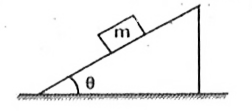In a situation the contact force by a rough horizontal surface on a body placed on it has constant magnitude. If the angle between this force and the vertical is decreased, the frictional force between the surface and the body will
increase
decrease
remain the same
may increase or decrease
The correct Answer is:B
To solve the problem, we need to analyze the situation where the contact force by a rough horizontal surface on a body has a constant magnitude, and the angle between this force and the vertical is decreased. We will explore how this affects the frictional force between the surface and the body.
1. Understand the Forces Involved:
- The contact force FC acts at an angle θ with the vertical.
- The normal force N acts perpendicular to the surface.
- The frictional force Ff acts parallel to the surface.
2. Identify the Components of the Contact Force:
- The contact force can be resolved into two components:
- Vertical component: FCy=FCcos(θ)
- Horizontal component: FCx=FCsin(θ)
3. Analyze the Normal Force:
- The normal force N is affected by the vertical component of the contact force. Since the contact force is constant, the normal force can be expressed as:
N=mg−FCy=mg−FCcos(θ)
- Here, mg is the weight of the body.
4. Effect of Decreasing the Angle θ:
- As the angle θ decreases, the vertical component FCy (which is FCcos(θ)) increases because cos(θ) approaches 1.
- This results in a decrease in the normal force N because more of the contact force is acting vertically.
5. Determine the Frictional Force:
- The frictional force Ff is given by:
Ff=μN
- Where μ is the coefficient of friction. Since N decreases as θ decreases, the frictional force Ff will also decrease.
6. Conclusion:
- Therefore, as the angle between the contact force and the vertical decreases, the frictional force between the surface and the body will decrease.
Final Answer:
The frictional force between the surface and the body will decrease.
- The contact force FC acts at an angle θ with the vertical.
- The normal force N acts perpendicular to the surface.
- The frictional force Ff acts parallel to the surface.
- The contact force can be resolved into two components:
- Vertical component: FCy=FCcos(θ)
- Horizontal component: FCx=FCsin(θ)
- The normal force N is affected by the vertical component of the contact force. Since the contact force is constant, the normal force can be expressed as:
N=mg−FCy=mg−FCcos(θ)
- Here, mg is the weight of the body.
- As the angle θ decreases, the vertical component FCy (which is FCcos(θ)) increases because cos(θ) approaches 1.
- This results in a decrease in the normal force N because more of the contact force is acting vertically.
- The frictional force Ff is given by:
Ff=μN
- Where μ is the coefficient of friction. Since N decreases as θ decreases, the frictional force Ff will also decrease.
- Therefore, as the angle between the contact force and the vertical decreases, the frictional force between the surface and the body will decrease.
The frictional force between the surface and the body will decrease.
Topper's Solved these Questions
- FRICTIONBOOK - HC VERMA ENGLISHCHAPTER - FRICTIONEXERCISE - Objective -2
5 Videos
- FRICTIONBOOK - HC VERMA ENGLISHCHAPTER - FRICTIONEXERCISE - Exercises
31 Videos
- FRICTIONBOOK - HC VERMA ENGLISHCHAPTER - FRICTIONEXERCISE - worked out Examples
10 Videos
- FLUID MECHANICSBOOK - HC VERMA ENGLISHCHAPTER - FLUID MECHANICSEXERCISE - All Questions
90 Videos
- GRAVITATIONBOOK - HC VERMA ENGLISHCHAPTER - GRAVITATIONEXERCISE - Question for short Answers
18 Videos
Similar Questions
Knowledge Check
The frictional force between two surfaces is independent of
ANature of the surfaceBSize of the bodyCArea of contactDMass of the body
Choose the correct statement(s) about the frictional force between two solid surfaces in contact
View SolutionWhat is the angle between frictional force and instantaneous velocity of the body moving over a rough surface ?
View SolutionIf we imagine two ideally smooth surfaces & if they are kept in contact, the frictional force acting between them is,
View SolutionA block of mass m is moving on a rough horizontal surface. μ is the coefficient of kinetic friction between the block and the surface. What is the net force exerted by the surface on the block?
View SolutionA body is placed on a rough inclined plane of inclination θ. As the angle θ is the increased from 0∘ to 90∘, the contact force between the block and the plane

View SolutionA block is sliding on a rough horizontal surface. If the contact force on the block is √2 times the frictional force, the coefficient of friction is
View SolutionHow does the distance of separation between two bodies affect the magnitude of the non-contact force between them ?
View Solution
